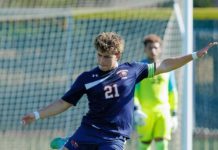
A golden eagle has the Wildlife Education and Rehabilitation Center to thank for his life.
Two volunteers from WERC rescued the majestic adult male eagle that a ranger found on the ground and unable to fly at Almaden Quicksilver Park in San Jose in late February.
The eagle was taken to the offices of Dr. Suzanne Colbert at the Princevalle Pet Hospital in Gilroy where she X-rayed his wings and discovered no fractures or dislocations. A wound was found, however, on the left wrist causing the wing to droop and it’s believed the eagle may have also suffered head trauma.
Dr. Colbert patched up the eagle’s wing, gave him medication and sent him on his way for some much needed tender loving care at WERC. The eagle is underweight at 7 pounds (a healthy male should be at 10 pounds) and has a wingspan of 6 feet. He remains in intensive care, but WERC reported the staff is optimistic about his recovery.
As of Monday, the wing wrappings were removed by Dr. Colbert and it no longer will have to take antibacterial medication, but pain medication is still ongoing.
“We removed the wing wrapping and the wounds are healing very well,” said Colleen Grzan, director of animal care at WERC.
Because of his restricted space where he’s residing at WERC in the hills of Morgan Hill, the wrappings are no longer necessary for his wing.
The eagle is undergoing physical therapy every day until he goes into an outdoor enclosure, perhaps as early as next week. His physical therapy includes daily wing stretches to strengthen his injured left wrist.
“(Rehab) is very intensive and only experienced volunteers are allowed to either hold him or give him medications,” said Grzan. “The person giving the medications or treating the feet/wings has to be completely confident in the person holding the eagle’s legs. The talons and beak are fearsome. We have to hold open the beak and stick a ‘pill-popper’ in to give medications.”
While the eagle is being worked on, other volunteers clean out the soft-sided kennel which has a perch and mat to protect the eagle’s feet from an infection called “bumblefoot,” said Grzan.
Dr. Colbert will again perform a check-up Monday, then make the decision as to whether or not the eagle can move into the outdoor enclosure.
The outdoor enclosure is large enough for him to spread his wings, but not big enough for him to fly around and stress the coracoid bone, said Grzan. He will be able to hop from perch to perch and go to the ground to eat. He will most likely need another X-ray before being allowed to go free flying into the 100-foot eagle aviary, said Grzan.
“We’re certainly optimistic that he’ll be released but that’s in the future. I’m really looking forward to seeing him flying free again. We’re doing everything possible to that end,” said Grzan.
What does is take to get the eagle on the road to recovery?
“(He’s) eating five small rats a day, but will likely eat much more once he’s outside and moving around,” said Grzan.
All wild birds are protected under state law and is therefore illegal for the eagle to be taken from the wild to be kept as a pet or even as a patient without federal and state permits.
WERC is the only facility in South Santa Clara County licensed by the California Department of Fish and Game and by the U.S. Fish and Wildlife Service to provide rehab services. They currently have a turkey vulture, a great horned owl and two red-shouldered hawks under their care. Many of the animals that come in during the winter season have badly broken wings from vehicle collisions and can’t be repaired, said Grzan.
WERC is a care center for injured and sick wildlife, and a nurturing center for orphaned wildlife too young to exist on their own. WERC operates as a temporary refuge to not tame but release animals back to their native habitat. It is not funded by any government agency and most services are free of charge.
To donate, visit www.werc-ca.org.














